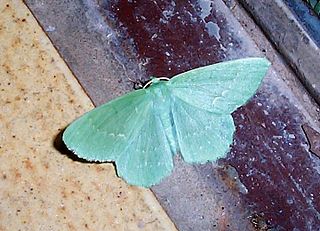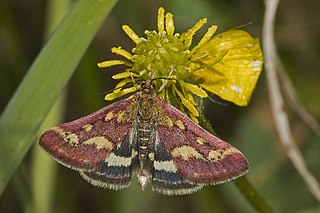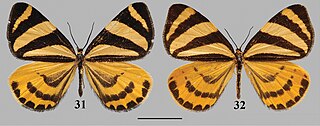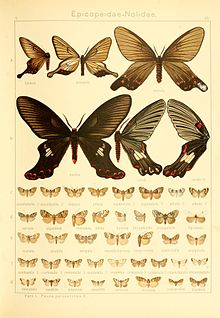
Macrolepidoptera is a group within the insect order Lepidoptera. Traditionally used for the larger butterflies and moths as opposed to the "microlepidoptera", this group is artificial. However, it seems that by moving some taxa about, a monophyletic macrolepidoptera can be easily achieved. The two superfamilies Geometroidea and Noctuoidea account for roughly one-quarter of all known Lepidoptera.

Riodinidae is the family of metalmark butterflies. The common name "metalmarks" refers to the small, metallic-looking spots commonly found on their wings. The 1532 species are placed in 146 genera. Although mostly Neotropical in distribution, the family is also represented both in the Nearctic, Palearctic, Australasian (Dicallaneura), Afrotropic, and Indomalayan realms.

The Drepanidae is a family of moths with about 660 species described worldwide. They are generally divided in three subfamilies which share the same type of hearing organ. Thyatirinae, previously often placed in their own family, bear a superficial resemblance to Noctuidae. Many species in the Drepanid family have a distinctively hook-shaped apex to the forewing, leading to their common name of hook-tips.

The Geometroidea are the superfamily of geometrid moths in the order Lepidoptera. It includes the families Geometridae, Uraniidae, Epicopeiidae, Sematuridae, and the recently established family Pseudobistonidae. The monotypic genus Apoprogones was considered a separate geometroid family of the Apoprogonidae by a minority, but is now subsumed under the Sematuridae.

Choreutidae, or metalmark moths, are a family of insects in the lepidopteran order whose relationships have been long disputed. It was placed previously in the superfamily Yponomeutoidea in family Glyphipterigidae and in superfamily Sesioidea. It is now considered to represent its own superfamily. The relationship of the family to the other lineages in the group "Apoditrysia" need a new assessment, especially with new molecular data.

Brachodidae is a family of day-flying moths, commonly known as little bear moths, which contains about 135 species distributed around much of the world. The relationships and status of the presently included genera are not well understood.
Whalleyana is an enigmatic genus of moths in the lepidopteran group Obtectomera, endemic to Madagascar. The genus contains two species, whose biology are unknown. The genus had been placed in the picture-winged leaf moths, (Thyrididae), but then was placed in its own family, and later elevated to its own superfamily ; see also Fänger (2004). The genus was named after Paul E. S. Whalley, a British entomologist. Genomic studies have found them to be most closely related to Callidulidae, and it is suggested that they should be placed in Calliduloidea.

Copromorphoidea, the "fruitworm moths", is a superfamily of insects in the lepidopteran order. These moths are small to medium-sized and are broad-winged bearing some resemblance to the superfamilies Tortricoidea and Immoidea. The antennae are often "pectinate" especially in males, and many species of these well camouflaged moths bear raised tufts of scales on the wings and a specialised fringe of scales at the base of the hindwing sometimes in females only; there are a number of other structural characteristics. The position of this superfamily is not certain, but it has been placed in the natural group of "Apoditrysia" "Obtectomera", rather than with the superfamilies Alucitoidea or Epermenioidea within which it has sometimes previously been placed, on the grounds that shared larval and pupal characteristics of these groups have probably evolved independently. It has been suggested that the division into two families should be abandoned.
Acanthoctesia or "archaic sun moths" is an infraorder of insects in the lepidopteran order, containing a single superfamily, Acanthopteroctetoidea, and a single family, Acanthopteroctetidae. They are currently considered the fifth group up on the comb of branching events in the extant lepidopteran phylogeny. They also represent the most basal lineage in the lepidopteran group Coelolepida characterised in part by its scale morphology. Moths in this superfamily are usually small and iridescent. Like other "homoneurous" Coelolepida and non-ditrysian Heteroneura, the ocelli are lost. There are variety of unique structural characteristics. There are two described genera of these primitive moths. Catapterix was originally described within its own family but Acanthopteroctetes shares with it a number of specialised structural features including similar wing morphology.

The insect order Lepidoptera consists of moths, most of which are night-flying, and a derived group, mainly day-flying, called butterflies. Within Lepidoptera as a whole, the groups listed below before Glossata contain a few basal families accounting for less than 200 species; the bulk of Lepidoptera are in the Glossata. Similarly, within the Glossata, there are a few basal groups listed first, with the bulk of species in the Heteroneura. Basal groups within Heteroneura cannot be defined with as much confidence, as there are still some disputes concerning the proper relations among these groups. At the family level, however, most groups are well defined, and the families are commonly used by hobbyists and scientists alike.

Cimeliidae, the gold moths, is a family of moths that is now placed in the macroheteroceran superfamily Drepanoidea, although previously placed in its own superfamily. Uniquely, they have a pair of pocket-like organs on the seventh abdominal spiracle of the adult moth which are only possibly sound receptive organs. They are quite large and brightly coloured moths that occur in southern Europe and feed on species of Euphorbia. Sometimes they are attracted to light. The family was first described by Pierre Chrétien in 1916.

Lyssa zampa, the tropical swallowtail moth or Laos brown butterfly, is a moth of the family Uraniidae. The species was first described by British entomologist Arthur Gardiner Butler in 1869.

The Obtectomera is a clade of macro-moths and butterflies, comprising over 100,000 species in at least 12 superfamilies.

Gracillariinae are a subfamily of moths which was described by Henry Tibbats Stainton in 1854.

Schistomitra is a moth genus in the family Epicopeiidae described by Arthur Gardiner Butler in 1881. The genus was regarded as a monotypic taxon for a long time, however a second species was newly described in 2019.

Deuveia banghaasi is a moth in the family Epicopeiidae. It is found in central China.

Oedematopoda is a genus of moths in the family Stathmopodidae. This genus is closely related to the genus Atkinsonia and tough to differentiate externally.
The Macroheterocera are a well supported clade of moths that are closely related to butterflies and other macro-moths.

Schistomitra joelmineti is a moth species in the family Epicopeiidae described by Si-Yao Huang and Yuan Zhang in 2019. The specific epithet is named in honor of Joël Minet

Mimaporia is a genus of moths in the Oriental swallowtail moth family Epicopeiidae consisting of two species, Mimaporia hmong and Mimaporia owadai. First described in 2017 by Shen-Horn Yen and Chia-Hsuan Wei, as the sole species Mimaporia hmong, from museum specimens held at the Natural History Museum, London. The second species, Mimaporia owadai was discovered two years after the initial description. Its members are found in Northern Vietnam, Northern India, and Sichuan Province in China.

















